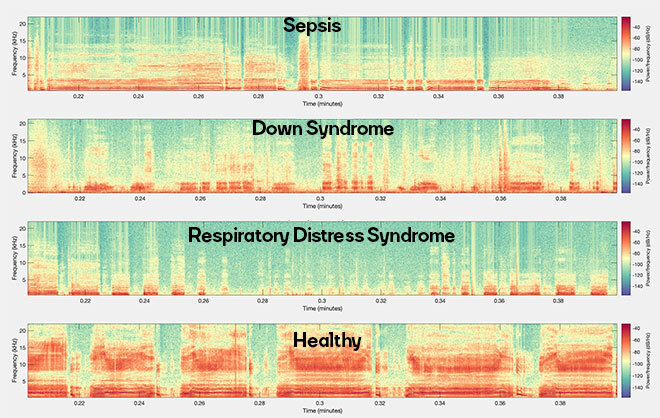Exploring Acoustical Attributes of Newborn Cries for Diagnosis

Achetée sur Gettyimages. Droits d’auteur.
According to UNICEF reports, about one third of under-25-year old deaths occur within the first month of life, a stage called the neonacy period. The figures regarding newborn mortality are tragic—2.3 million deaths in 2021—and they are even more tragic when we realize that these numbers are not going to decline any time soon. By 2030, 63 countries are going to miss the projected newborn mortality reduction goals defined by UNICEF [1].
Why Do Babies Cry?
Dealing with newborn health is delicate since they cannot describe their needs, and crying does not reflect their condition. The main question is: “Is there more to the crying than meets the eye?” To answer this, we must first know why newborns cry and how the cry is generated. Newborns cry for obvious reasons: hunger, wet diaper, etc.; these are communicative attempts. The reasons behind crying can be divided into four main categories: sensorimotor maturation [2], central nervous system development [3], communication, and releasing excessive energy [4]. This means that not all cries are voluntary and controlled by the newborn. The cry itself is the result of a collaboration between various organs in the body such as the respiratory system, central and peripheral nervous systems, and several muscles and limbs such as the lips and tongue. If any of these organs fails to function properly, it would be logical to expect that the resulted cry differ from a normal “healthy” cry [5]. This suggests the potential of translating newborn cries for diagnosis purposes.
Relating Cries to Pathologies
Since 1878, researchers have tried to explore newborn cries for cues that pointed to pathologies [6]. In order to gain a deeper understanding of the cry signals acoustical structure spectrograms were analyzed from different cry signals, as shown in Figure 1. The researchers observed that cry signals from healthy newborns follow a consistent pattern, whereas cry signals of newborns suffering from pathology lack consistency. More significantly, there is a meaningful difference in the acoustical structures of various pathologies.

Figure 1. Spectrograms of healthy and pathologic newborn cry signals.
Although the spectrographic analysis unlocked many hidden cues in attributing the acoustical structure of the cry signal to pathologies, it was not sufficient for exploring all aspects of the cry signals, nor accurate when it came to investigating a larger number of patients. Hence, the researchers developed an automated approach called Newborn Cry Diagnostic Systems (NCDS) [7]. The NCDS designs were mainly influenced by the advancement in machine learning and deep learning approaches. However, compared to other audio processing applications such as speech processing, NCDS present great opportunities for improvement. NCDS—similar to all audio-processing frameworks—consist of three main components: preprocessing, feature extraction, and classification [8].
Moreover, certain aspects regarding the study of a pathology remain unexplored. For example, most NCDS designs to date only focused on the separation and identification of a certain pathology group from a healthy group. There is no prior research attempting to compare two pathology groups or identifying a certain pathology among other pathology groups. Besides, among the pathologies that have been studied so far, sepsis remains undiscovered despite being the cause of nearly 15% of all newborn mortality [9]. Sepsis is so fatal that the treatment could be started even without corroborative clinical data [10], yet it remains dangerous since it can be so easily missed.
When Cries Become Efficient Biomarkers
Our database presents real-world conditions: it includes a high diversity of races, origins, reasons for crying, and includes more than 30 pathologies. The recording tool is simple and accessible for even low-income settings; the cries were recorded with no predefined conditions and in the presence of noise. Thus, any study performed with this dataset takes us one step closer to developing a practical framework.
In our research, we addressed the aforementioned gaps through the introduction of novel machine and deep learning approaches, and highlighted the newborn cries as powerful biomarkers in identifying pathologies that were not investigated before. Our NCDS designs are simplistic and inexpensive, while being highly efficient.
From a methodological perspective, we focused on enhancing the feature space through novel extraction methods, selection, and fusion of the features. We approached the cry signal as both a pre-speech phenomenon and having musical components. Then, we fine-tuned the classification approaches to fit our feature space and fused their decisions. From an application point of view, our contributions were several-fold: targeting sepsis as a leading newborn mortality cause, distinguishing between two closely entangled pathologies, identifying a certain pathology from an ensemble of other pathologies, and developing an early alert for newborn caregivers capable of marking a newborn as unhealthy regardless of pathology group, race, and reason for crying.
Through our studies, we showed that the differences in the acoustic structures of the newborn cry are dependent on the pathology. Besides, we showed it is feasible to distinguish between two or more pathologies through an automated framework. Finally, we believe that our work can help lower the mortality rate in low-income settings suffering from a lack of medical experts and equipment, since it is non-invasive and does not require costly technologies. Our design can act as an expeditious and complementary tool for candidate newborns with a health risk, without the need for any clinical tests so that the caregivers can be more vigilant and provide adequate treatment for the newborns.
Additional Information
For more information on this research, please read the following paper:
Khalilzad Z, Tadj C. Using CCA-Fused Cepstral Features in a Deep Learning-Based Cry Diagnostic System for Detecting an Ensemble of Pathologies in Newborns. Diagnostics (Basel). 2023 Feb 24;13(5):879. doi: 10.3390/diagnostics13050879. PMID: 36900023; PMCID: PMC10000938.



